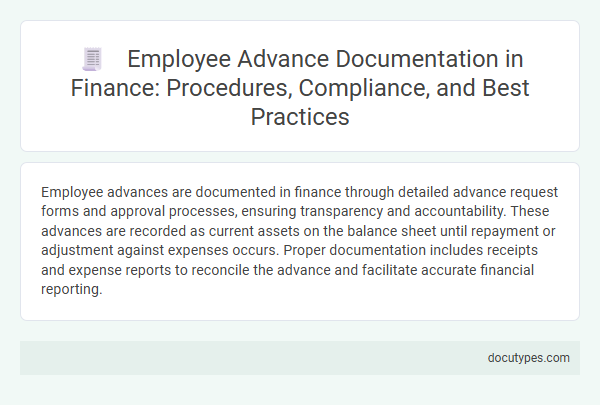Employee advances are documented in finance through detailed advance request forms and approval processes, ensuring transparency and accountability. These advances are recorded as current assets on the balance sheet until repayment or adjustment against expenses occurs. Proper documentation includes receipts and expense reports to reconcile the advance and facilitate accurate financial reporting.
Introduction to Employee Advance Documentation
Employee advances are funds provided by a company to employees before the official expense or payment due date. Documenting these advances accurately is crucial for financial transparency and accountability.
- Advance Request Form - Employees submit a standardized form detailing the purpose and amount of the requested advance.
- Approval Procedure - Your finance department verifies and authorizes the advance based on company policies.
- Accounting Record - The advance is recorded as a receivable in the accounting system until it is settled or reimbursed.
Importance of Employee Advance Procedures
Employee advances are documented through systematic procedures involving advance request forms, approval workflows, and detailed ledger entries. Accurate documentation ensures transparency and accountability in financial records, facilitating smooth audit processes.
Establishing clear employee advance procedures minimizes the risk of fund mismanagement and unauthorized disbursements. Maintaining organized advance documentation supports compliance with internal controls and regulatory requirements.
Types of Employee Advances in Finance
| Type of Employee Advance | Description | Documentation Method |
|---|---|---|
| Travel Advance | Funds provided to employees to cover expenses incurred during business travel, including transportation, accommodation, and meals. | Travel advance requests are documented with a formal advance form, approved by management, and accompanied by travel itineraries. Expense reports and receipts are submitted post-travel to reconcile the advance. |
| Salary Advance | Partial payment of salary before the scheduled payday, typically granted in cases of urgent financial need. | Salary advance agreements specify the amount and repayment schedule, documented through payroll records and employee authorization forms. |
| Petty Cash Advance | Small sums of money advanced to employees for minor work-related expenses such as office supplies or local errands. | Petty cash vouchers record the amount advanced, purpose, and date. Receipts and reconciliation reports are maintained for accountability. |
| Project Advance | Funds advanced to employees or project teams to cover initial costs related to specific projects or assignments. | Project advance requests include detailed budget plans and approvals. Expense documentation and project completion reports reconcile the advance. |
| Equipment or Asset Advance | Advance payments to employees for the purchase of equipment or assets required for work duties. | Purchase requests and approval forms are essential. Invoices and purchase receipts validate the use of the advance. |
Standard Documentation Requirements
Employee advances are systematically recorded to ensure transparency and accurate financial tracking within an organization. Proper documentation helps in reconciling advances against payroll or expenses, maintaining compliance with internal policies and accounting standards.
- Advance Request Form - A formal document submitted by the employee detailing the amount and purpose of the requested advance.
- Approval Authorization - Sign-off from authorized personnel to validate and approve the advance prior to disbursement.
- Advance Repayment Record - Documentation of repayment schedules or deductions reflected in payroll to offset the advance.
Steps for Processing Employee Advance Requests
Employee advances in finance require precise documentation to ensure accurate tracking and accountability. Proper processing steps maintain financial integrity and compliance within the organization.
- Submission of Advance Request - Employees formally submit a detailed advance request form specifying the purpose and amount needed.
- Approval Workflow - The request undergoes review and approval by designated managers or finance personnel based on company policy.
- Recording in Finance System - Approved advances are documented in the accounting software with reference numbers and linked to the employee's profile.
- Disbursement of Funds - The finance department issues the advance through payroll or direct transfer, noting the transaction for audit trails.
- Reconciliation and Reporting - Employees must submit expense reports or return unused funds, which finance reconciles against the advance records.
Systematic documentation of employee advances ensures transparency and supports efficient financial management.
Compliance with Regulatory Standards
Employee advances are documented through formal accounting entries and detailed record-keeping to ensure transparency and accuracy. Compliance with regulatory standards requires maintaining clear, auditable documentation that reflects the purpose, amount, and repayment terms of the advance.
Financial policies mandate the use of standardized advance request forms and approval workflows to control disbursement. Regulatory frameworks such as GAAP and IFRS emphasize reconciliation of advances in financial statements to prevent misstatements. Firms must also retain supporting documents for audits and regulatory inspections, ensuring adherence to internal controls and external compliance requirements.
Risk Management in Employee Advance Documentation
How are employee advances documented in finance to ensure effective risk management?
Employee advances are recorded through detailed advance request forms and approval workflows that create a clear audit trail. This documentation reduces the risk of misappropriation by enforcing accountability and enabling timely reconciliation of advanced amounts.
Best Practices for Recordkeeping
Employee advances are documented through detailed records that include advance requests, approval forms, and repayment schedules. Accurate documentation ensures transparency and aids in effective tracking of outstanding amounts.
Best practices for recordkeeping involve maintaining digital and physical copies of all related documents and regularly updating the employee advance ledger. You should establish clear policies to standardize the process and perform periodic audits to prevent discrepancies.
Common Challenges and Solutions
Employee advances are documented in finance through detailed advance request forms, approval workflows, and ledger entries to ensure accurate tracking and accountability. Common challenges include discrepancies in reimbursement amounts, delayed approvals, and incomplete documentation leading to audit issues. Solutions involve implementing automated expense management systems, enforcing strict submission deadlines, and regular reconciliation between advances and expense reports.
How Are Employee Advances Documented in Finance? Infographic

